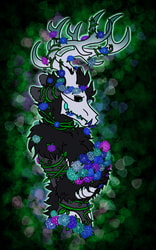Sign In
CloseGrieving Flowers Disease Info by Void-Lizard

GRIEVING FLOWERS DISEASE - The disease affects people dealing with extreme grief over the death of a loved one. The victim will cough up chrysanthemums as well as have them bloom in their hair. It affects people dealing with not being able to move on from a death and is only cured when the victim makes peace with the loss. It's not fatal but is rather inconvenient as it causes pain, coughing, and the expelled petals and flowers are a reminder of the victim's sorrow. It can be either cured naturally or the flowering plant can be surgically removed from the lungs. It affects mostly humans and pyre dragons, but has been observed in undeads, gryphons, wildkin, and rarely in wild non-sapient animals.
SYMPTOMS -
Starts with a raspy, dry cough and may cause slight chest pain. At first, coughing and small expelled petals are somewhat rare, only happening a couple times a day. As the disease takes hold, coughing becomes slightly more painful, fits become common, petals are coughed up more often and several at a time. Petals become larger and eventually entire blossoms are coughed up in addition. Blood on the flowers is uncommon, but accompanies chest pain. In later stages, chrysanthemums will also bloom in the victim's hair.
Symptoms start within a week of victim becoming aware of the death in question. After symptoms start, coughing ramps up after about a week in addition to chest pain starting, flowers in hair and full blooms being expelled at about 2 weeks, and max severity being reached after roughly 2 1/2 weeks.
CAUSE -
Extreme grief and inability to move on from death of loved one.
The death can be human or animal, the only important factor being the victim unable to accept and move on. Multiple deaths may be involved, but grieving the general loss of life of strangers from a tragic event -will not- trigger the disease. A personal connection is required. In the vast majority of cases, positive feelings towards the dead are required by the victim.
It is currently unknown how it is caught. No pathogen or correlation has been found, and not nearly everyone mourning a death comes down with the disease. Roughly 20% of people dealing with personal loss get GFD. Being taught about death and how to mourn and let go peacefully from an early age has been shown to reduce the likelihood of catching GFD, but exact numbers vary.
CURE -
Natural: When the victim makes peace with the death, the disease is cured and fades within a day.
Surgery: The flowering plant can be removed from the lungs. If any is missed, it will bloom again, taking a couple weeks to get back to pre-surgery capacity. Aside from the effects of such an invasive procedure, this has little overall effect other than slowing the disease and giving a small window of relief from symptoms.
Magic: Rituals and magic may be used to treat the symptoms and lessen the pain. Coughing and expulsion of flowers and petals can be almost completely suppressed in this manner. Daily rituals are required to maintain this. This is not a true cure.
FATALITY/RISK -
GFD is non-fatal by default. It's highly inconvenient and can be painful, but generally will not kill the victim. However, pre-existing ailments can make GFD a threat, such as asthma and lung damage or diseases. Mental trauma is thought to increase severity of GFD, but this has not been proven undeniably.
In very rare extreme cases, the flowers spread to the heart and cause damage. This generally only happens with the worst of grief and kills the victim quickly, around a week after the death(s) that triggered it. Even when caught early, the grief is often so severe that recovery from it, let alone the disease, is unlikely. A literal case of death by heartbreak.
Victims often report emotional distress, as the petals coughed up are a reminder of the grief. While not a risk on its own, this can spike mental problems, leading to high potential for self harm in victims with a history of it, and physical damage from stress in weakened individuals.
AFTER EFFECTS -
No lasting after effects occur if the disease is cured naturally.
If surgery is used, the victim partially loses the ability to deeply bond with others.
Many recovered victims see it as a learning experience and are less likely to mourn without recovery in the future.
MISC -
The flower coughed up will always be chrysanthemums. They are a symbol of grief and death.
While not everyone will deal with GFD or personally know someone who has, most people know of -someone- in their community who has dealt with it.
The disease is based in magic. It persists through shapeshifting, scaling up or down to match the rough equivalent of lung capacity and severity in all forms.
GFD is a variation of Hanahaki, revolving around death and grief instead of unrequited love.
Flowers expelled or removed from the victim stay alive and fresh for a couple days without water, but will always wither and die quickly after decay begins. Sunlight, plant food, soil, and magic will not save the plant. These flowers do not carry pollen and will not trigger allergies. No harm has been reported from eating fallen blossoms.
VARIANTS -
GFD by proxy: Sometimes called "gravekeeper's syndrome", some people are able to pick up the disease by close prolonged contact with people dealing heavily with grief. Often affects first responders, medical workers, morticians, spirit guides, and councilors. There are magic wards available to protect people at risk of GFD by proxy. These symptoms go away on their own, as it isn't the victim's grief that sparked it. Average duration is a week, but it may become chronic.
Chronic GFD: Some victims will never be cured and will live with GFD their entire lives. It will flare up more when faced with additional grief or when the victim focuses heavily on the course of the grief. Chronic GFD by proxy may happen but is less severe than the regular variant.
After learning about a fictional disease called hanahaki, I decided to do my own little version for fun! The name may change at some point, as it was originally a placeholder, but I might end up keeping it as is.
Submission Information
- Views:
- 143
- Comments:
- 0
- Favorites:
- 0
- Rating:
- General
- Category:
- Literary / Other



